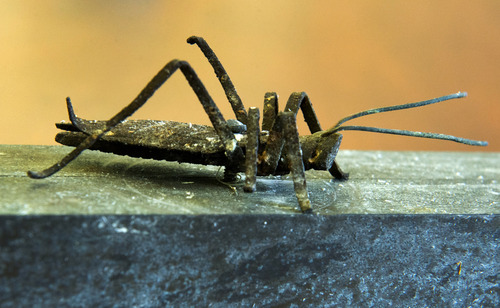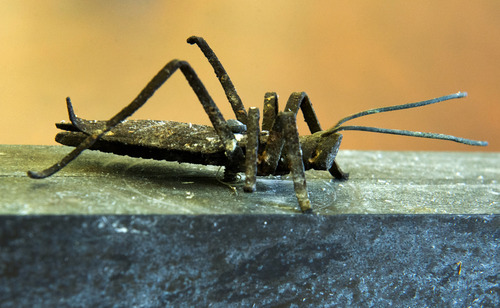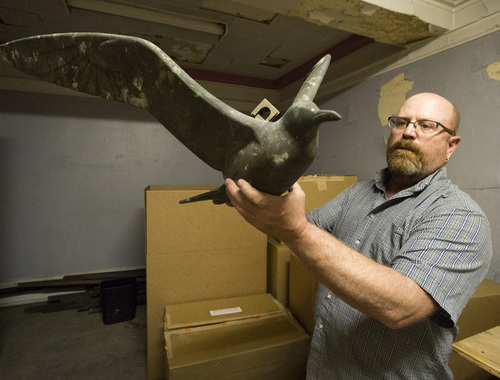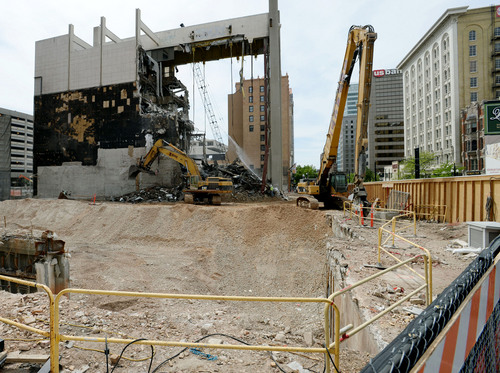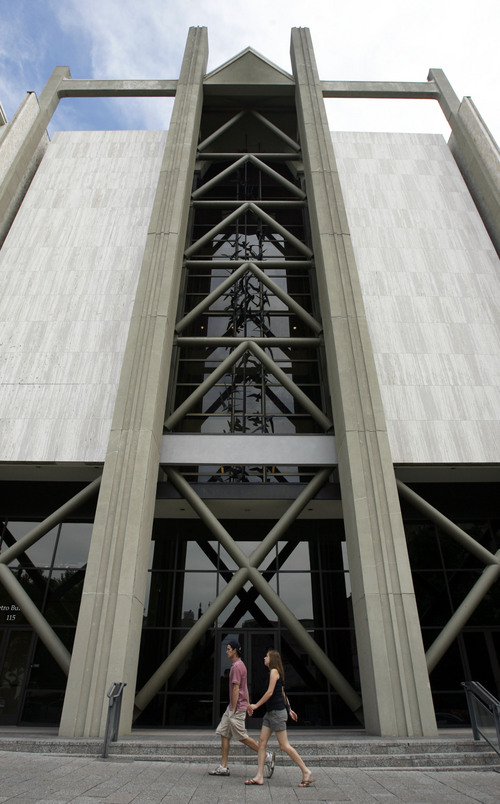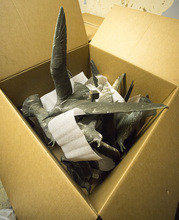This is an archived article that was published on sltrib.com in 2014, and information in the article may be outdated. It is provided only for personal research purposes and may not be reprinted.
Fifty years ago this summer, 100 seagulls took flight on Salt Lake City's Main Street — and stayed there for decades.
Now, 65 of them sit in cardboard boxes in a storage room in a dilapidated theater, waiting for their new home to be built.
The other 35 are missing.
The bronze-on-nickel seagulls are part of a sculpture, "The Gulls of Salt Lake City," by California artist Tom Van Sant. The sculpture was installed in 1964 in the then-new Prudential Federal Savings building.
That building, at 115 S. Main in downtown Salt Lake City, is the last of several to be demolished to make way for the city's new performing arts center. By the end of last week, only the central steel superstructure from which the entire building once hung remained.
Crews removed "The Gulls" before demolition began and put the birds in storage. City officials want "The Gulls" included in the performing arts center's future.
"The city's been very deliberate about saying we want them incorporated," said City Councilman Stan Penfold. "The seagulls are going in the building, someplace."
"The Gulls" were incorporated in the original design of the Prudential Federal. Van Sant collaborated with the architect, William Pereira, who is best known for designing San Francisco's iconic Transamerica Pyramid.
"It came to be one of my first large architectural [projects]," Van Sant, now 83, said in a phone interview Friday from his home in Santa Monica, Calif.
Van Sant designed and built the sculpture himself and installed the gulls with the assistance of master welder Timothy E. Smith. It consisted of 100 gulls made from electro-deposited bronze on nickel, which made them lightweight. Van Sant attached the birds to three stainless steel rods, 120 feet long, held in tension between the roof and a sunken garden below street level.
"I connected all those birds, on scaffolds in February, with snow on the planks," Van Sant said. "I wasn't scared until I got right to the last ones" on the top floor.
At the sculpture's very top, in the window of the CEO's office, Van Sant added a whimsical touch: a metal cricket, about 5 inches long. The insect is a reference to the famous story of the seagulls devouring the swarms of crickets that threatened the Mormon pioneers' crops.
"It's really cute," said Roni Thomas, public arts program manager for the Salt Lake City Arts Council, of Van Sant's cricket.
The building and "The Gulls" were heavily praised as signs of Salt Lake City's progress and sophistication when the building opened on June 29, 1964.
"One almost gets the feeling they're actually alive and are rising purposefully skyward," read a celebratory insert that ran in Salt Lake City's newspapers for the building's grand opening.
The building became a popular destination for locals and tourists. One of the highlights was the rotating display in the sunken garden, with tropical flowers in the summer and a 25-foot blue spruce for Christmas.
Prudential Federal Savings, a Utah-based savings and loan, adopted "The Gulls" as a corporate emblem, "because the seagull served our valley at a time of need — just as PFS fulfills a need for thousands of Intermountain families," according to ad copy from 1965. (The company named all 100 gulls Franklin, for the birds' species, the Franklin's gull.)
"I remember going back and seeing it once, just driving by and enjoying the fact that it was all properly attached," Van Sant said. "I was a young guy [when I did it], and there was no way of testing it."
The seagulls remained as the fortunes of Prudential Federal Savings turned. PFS changed its name in 1989 to Olympus Bank to avoid confusion with The Prudential, the famed insurance company. The now-defunct Washington Mutual bought Olympus Bank in 1995 and moved Olympus' headquarters to WaMu's Seattle offices.
In the meantime, the building was modified repeatedly. The biggest change, according to Kirk Huffaker, of the Utah Heritage Foundation, came in 2001, when the sunken garden was eliminated and the sidewalk built over it.
That's when the bottom third of "The Gulls," the basement and first-floor sections, were lopped off the sculpture, Huffaker said.
Van Sant said he was unaware of the alteration.
No one in city government knows what happened to the 35 seagulls.
"We looked. We said, 'Let's find those,' " Thomas said. But no one did.
The remaining 65 seagulls were taken down this year and placed in cardboard boxes, which now sit in a storage room in the old Utah Theatre across the street. (The cricket is on Thomas' desk at the Art Barn for safekeeping.)
Glen Richards, the Arts Council's public arts project manager, said Metal Arts Foundry, of Lehi, will restore the 65 seagulls. Over the decades, some birds have become worn, while others have gathered what Richards called "two layers of patina" — the second one made of bird poop.
Thomas said the city intends to contact Van Sant about the sculpture and its restoration. Van Sant expressed surprise that officials didn't call him before moving "The Gulls."
Salt Lake City has allocated $200,000 to recover and restore the sculpture, said Justin Belliveau, deputy manager of the Redevelopment Agency of Salt Lake City. Less than 10 percent of that has been spent, he added.
It's a bit early to say exactly how the sculpture will be included in the center's design, said Jeffrey Berke, a spokesman for the project's developer, Garfield Traub Swisher Development. After all, demolition is still being completed, and groundbreaking won't happen until June.
"We want to find a location that is architecturally appropriate for an artwork of this size and historical relevance," Berke said. Other factors to be considered in placing the sculpture include preventing damage to the sculpture and ensuring it's in a place where people can enjoy it.
Belliveau said the decision process should get under way in a couple of months.
So while the performing arts center is being built — with a scheduled completion in June 2016 — the 65 seagulls wait.
The sculpture, Penfold said, "lives on, regardless of location. It's got a life beyond the original location. It tells a story of the history of the city."
Van Sant said he is flattered that his work is being preserved beyond the life of the building for which it was made.
"I'm just grateful they've served this half-century of service," he said, "and none of them came off."
Twitter: @moviecricket



